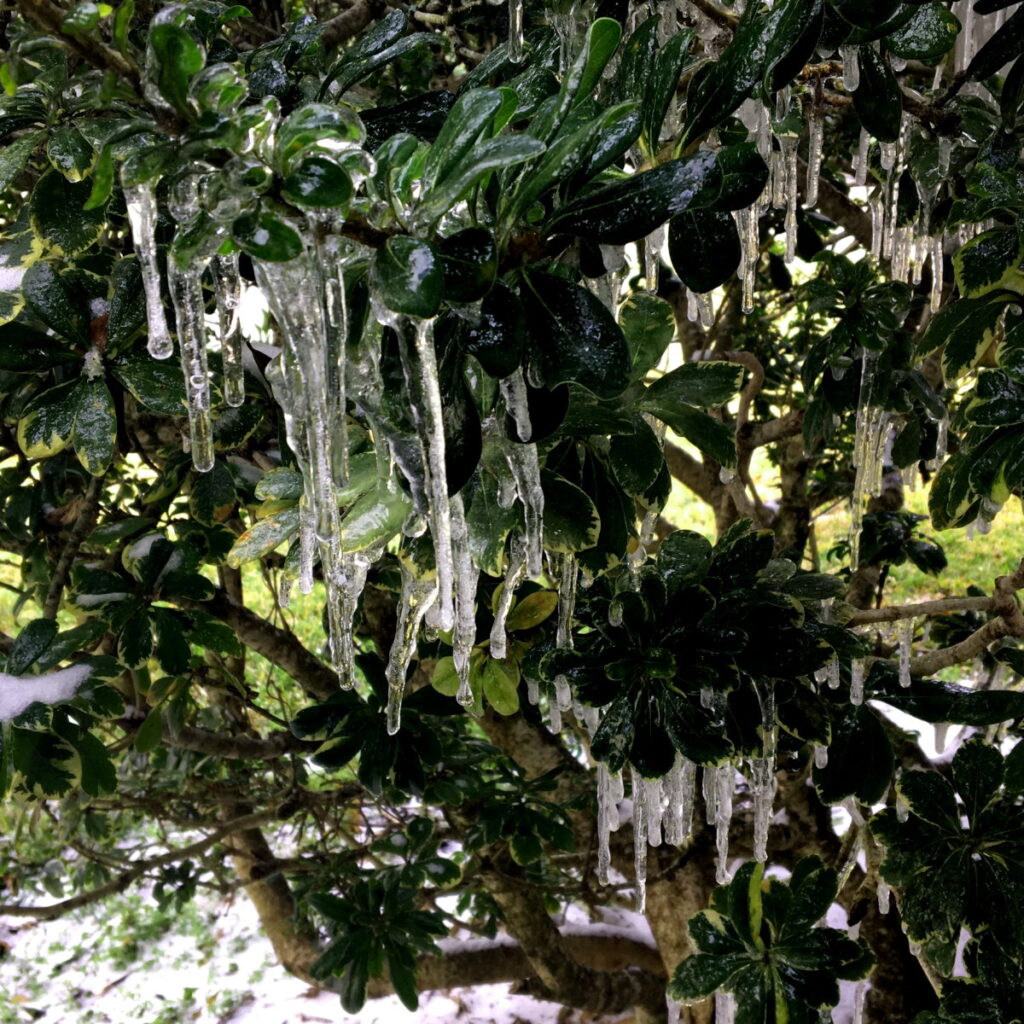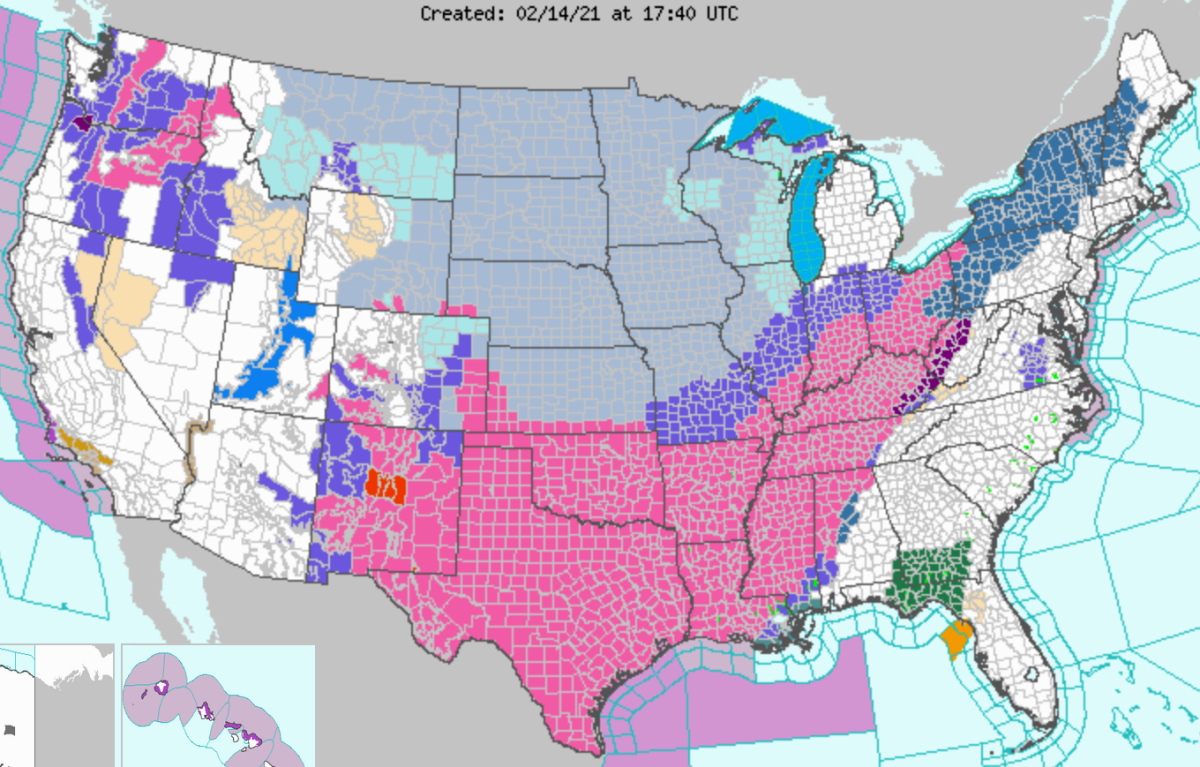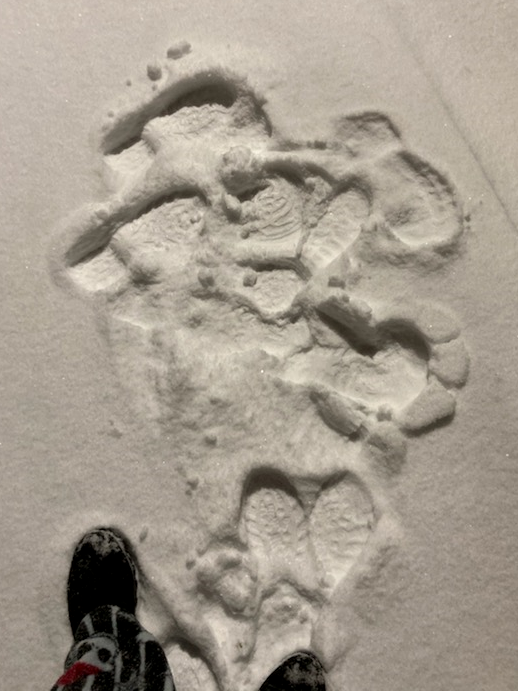
Houston, Feb. 15, 2021. Texas Climate News
Even in a human-warmed climate, fierce outbreaks of cold, snow and ice can still strike the Lone Star State. Case in point: an unusually intense and prolonged February cold wave that enveloped most of the central U.S., including Texas, by Valentine’s Day. On the morning of Feb. 14, advisories from the National Weather Service (NWS) for snow, ice, extreme cold and low wind chills covered nearly all of the nation between the Rockies and Appalachians.
By midday, all of Texas was plastered by winter storm warnings – a rare if not unprecedented occurrence.

At midday on Feb. 14, winter storm warnings (shown in pink) covered all of Texas, Oklahoma, and Arkansas and nearly all of Louisiana and Mississippi, extending to the northwest Gulf Coast. National Weather Service
Before this episode wanes, much of central and east Texas will see its coldest temperatures in at least 30 years. A week-long period below freezing may strike Dallas-Fort Worth, and record-long stretches below 40 degrees F are possible in Austin, San Antonio, and Houston. A series of snowfalls could end up producing a foot or more in pockets from DFW to Texarkana. Even Houston was bracing for a sharp bout of freezing rain, sleet and snow, with temperatures predicted to drop below 15 F and lower wind-chill numbers.
This storm’s impacts may be vast and far-reaching, especially with millions more people living in Texas now than during the frigid onslaughts of the 20th century.
Houston native Matt Moreland, a former lead forecaster with the NWS in Houston-Galveston and now meteorologist in charge of the San Diego office, is watching the unfolding scenario intently.
“This will be the most impactful cold outbreak since 1989,” said Moreland. In parts of the Houston area, he added, “the extreme temperatures mean that ice will form on every surface: every road, highway, sidewalk, driveway, etc. It takes only small amounts of ice and snow accumulations at these temperatures to render travel impossible.”
Local weather versus global climate
It’s a timeworn tradition for those who deny or discount human-caused climate change to use high-profile episodes of winter weather as cudgels. After a sizable Washington, D.C., snowfall in February 2015, Republican Sen. James Inhofe of Oklahoma — who once called climate change “the greatest hoax ever perpetrated on the American people” — famously brought a snowball to the Senate floor.
Needless to say, a snowball doesn’t count as peer-reviewed evidence, and Texas’ Arctic invasion of February 2021 does not mean that global warming has been canceled. To find the most obvious fingerprints of climate change, you’ve got to inspect the trends rather than one-off events. This month notwithstanding, the coldest temperatures recorded each year in cities across the nation, including Texas, have trended upward over the past 50 years.
What about snowfall? The higher temperatures brought by climate change are clearly messing with the hydrologic cycle, intensifying the heaviest rainfalls and drying out the landscape more intensely during so-called “hot droughts.” On average, according to Climate Central, an independent scientific and communications organization, warming temperatures are tending to diminish annual snowfall across the South, while concentrating snows toward winter and away from fall and spring nationwide.

Austin, Feb. 14, 2021. Pixie Phoenix
When conditions are just right – such as in a prolonged cold wave – snowfall can still rival or beat records of yore. February 2015, the month of Inhofe’s snowball demo, was the snowiest month in Boston’s history, with 64.8 inches. Yet the month’s total precipitation of 3.37 inches was very close to the long-term average of 3.25 inches. What made the difference? This was Boston’s second coldest month on record, which means that when precipitation did arrive, it was virtually all in the form of snow, as opposed to New England’s notorious cold rains.
Snow is also being measured more carefully than it was decades ago, which may be pushing up the accumulations at some locations.
For a reminder of what Texas’ infamously variable climate regime is capable of, look no further than February 1895, the second coldest month in Houston history, when the Gulf Coast got pummeled by its most spectacular snowfall on record. As recounted by Space City Weather, Houston reported a low of 10 F, followed by 20 inches of snow on Feb. 14-15.
According to the Houston Post (as cited by Space City Weather), “the streets were silent and deserted, and the almost trackless snow told the tale of a city’s quiet slumbers.”
Bob Henson is a contributing editor of Texas Climate News. A meteorologist and science writer based in Colorado, Henson is the author of “The Thinking Person’s Guide to Climate Change.”

Austin, Feb. 15, 2021. Darrold Smith

